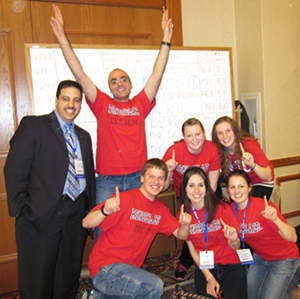 A team of undergraduate and graduate students from Rensselaer Polytechnic Institute recently won the 2011 National GeoChallenge for their innovative earth wall design.
A team of undergraduate and graduate students from Rensselaer Polytechnic Institute recently won the 2011 National GeoChallenge for their innovative earth wall design.
The annual competition, sponsored by the American Society of Civil Engineers (ASCE) Geo-Institute, pits teams of university students against each other in a very structural, earthy competition: using sand as a meaningful, weight-bearing construction medium.
The Rensselaer team placed first among the 16 finalist university teams invited to compete in March at the ASCE Geo-Frontiers 2011 conference in Dallas. For their victory, the Rensselaer team received the Atterberg Cup at the awards ceremony, attended by more than 2,000 members of the international civil engineering community.
“I was very confident in our team. We spent a lot of time on our design, and we tried as hard as we could,” said Rensselaer team leader Andrew Yeskoo, a senior civil and environmental engineering major. “It was a great few days at the competition and attending the conference. Plus, it was excellent that we won.”
Along with Yeskoo, Rensselaer GeoChallenge team members include civil engineering undergraduates Tamara Desrosiers, Meghan Hatton, and Heather Higgins, as well as civil engineering graduate students Maggie Exton and Waleed El-Sekelly. Many of the students work in the Rensselaer Center for Earthquake Engineering Simulation (CEES) with Research Engineer Anthony Tessari and Professor Tarek Abdoun.
“The National GeoChallenge Competition is a great opportunity for our students to apply their technical knowledge and show their outstanding engineering talent as they compete with the top schools in the nation,” said Abdoun, faculty adviser to the Rensselaer GeoChallenge Team, and the Judith and Thomas Iovino ’73 Professor in Civil Engineering and associate dean for research in the School of Engineering. “I am extremely proud of our student team. They worked very hard in all phases of this competition, and they certainly deserve such a prestigious award.”
The GeoChallenge team started their material testing and designs in October. The challenge involves designing and building reinforcements for a mechanically stabilized earth (MSE) wall using limited materials. MSE walls, commonly used for bridge embankments, dams, and dikes, are generally made using soil reinforced with steel or geotextiles. In the GeoChallenge competition, the MSE walls were made from poster board, and the reinforcements had to be constructed solely of paper and attached with adhesive tape.
All of the GeoChallenge teams had a large wooden box with no top and a removable side. Students used their paper MSE wall as the missing box side, and the competition tested if the MSE wall could support the specified load without failing. The box was filled with sand and soil, and the goal is to use the least amount of paper and tape reinforcement on the MSE wall to support the load.
“In a real-world situation, the less reinforcement material you use, the less expensive the overall structure would be to construct,” Yeskoo said. “MSEs are neat because they’re relatively cheap to build as compared to big metal structures, and because you’re actually using the soil as a construction medium.”
Yeskoo said the competition was considerably more challenging this year than in past years, as the competition tested surface load as well as lateral load. The Rensselaer team’s design supported 50 pounds of surface load, along with 25 pounds of lateral load — while using only 5.7 grams of reinforcing material.
For more information on Civil Engineering research at Rensselaer, see the Rensselaer Department of Civil and Environmental Engineering website, http://cee.rpi.edu/research.
Contact
Michael Mullaney
+1 518 276 6161
E-mail: mullam@rpi.edu











